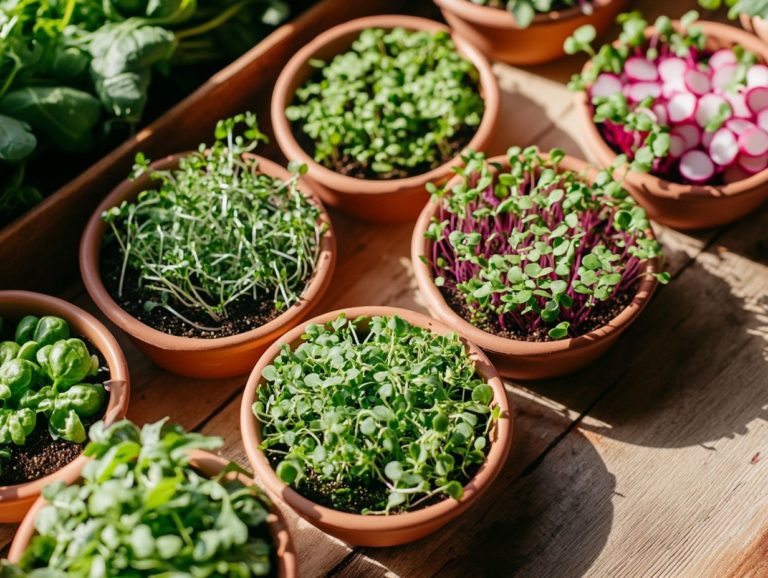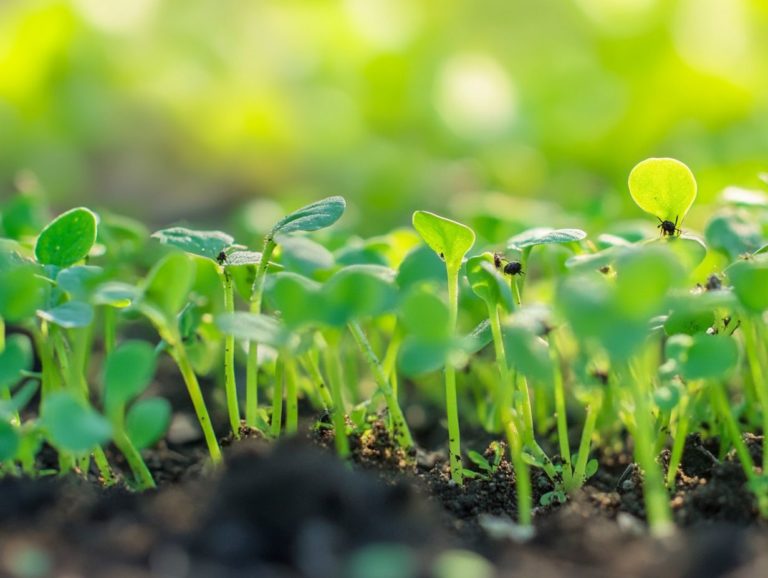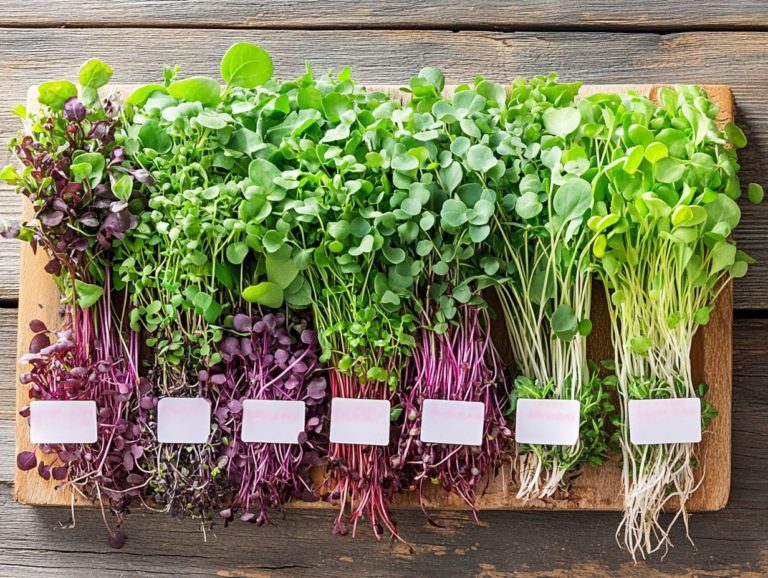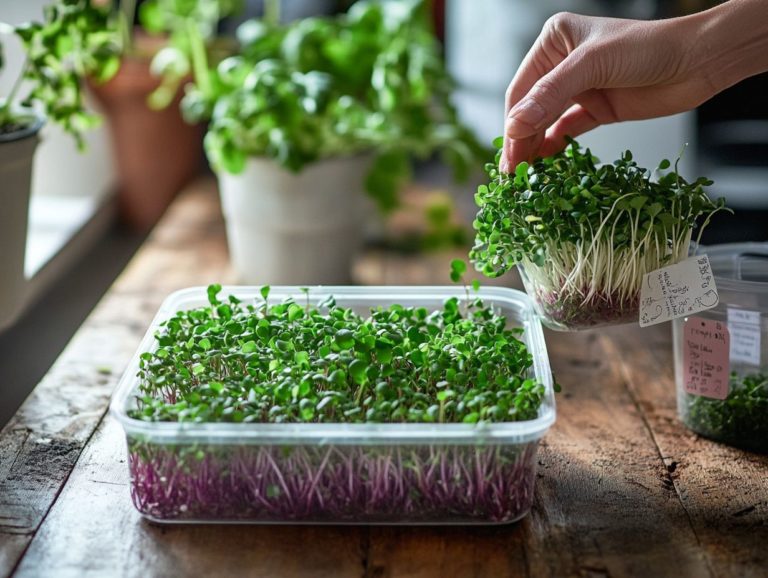What Are the Best Microgreens for Juicing?
Microgreens are those delightful little powerhouses of nutrition that have taken the health scene by storm. Not only are they incredibly versatile in the kitchen, but they also pack a punch when it comes to juicing.
Don t miss out on the benefits of adding these greens to your diet impressive nutrition and potential health perks await!
In this journey, you ll discover the best microgreens for juicing, receive a clear guide on how to grow your own, and gather tips for enhancing both their flavor and health benefits.
Embrace the vibrant world of juicing microgreens and elevate your culinary experience!
Contents
Key Takeaways:
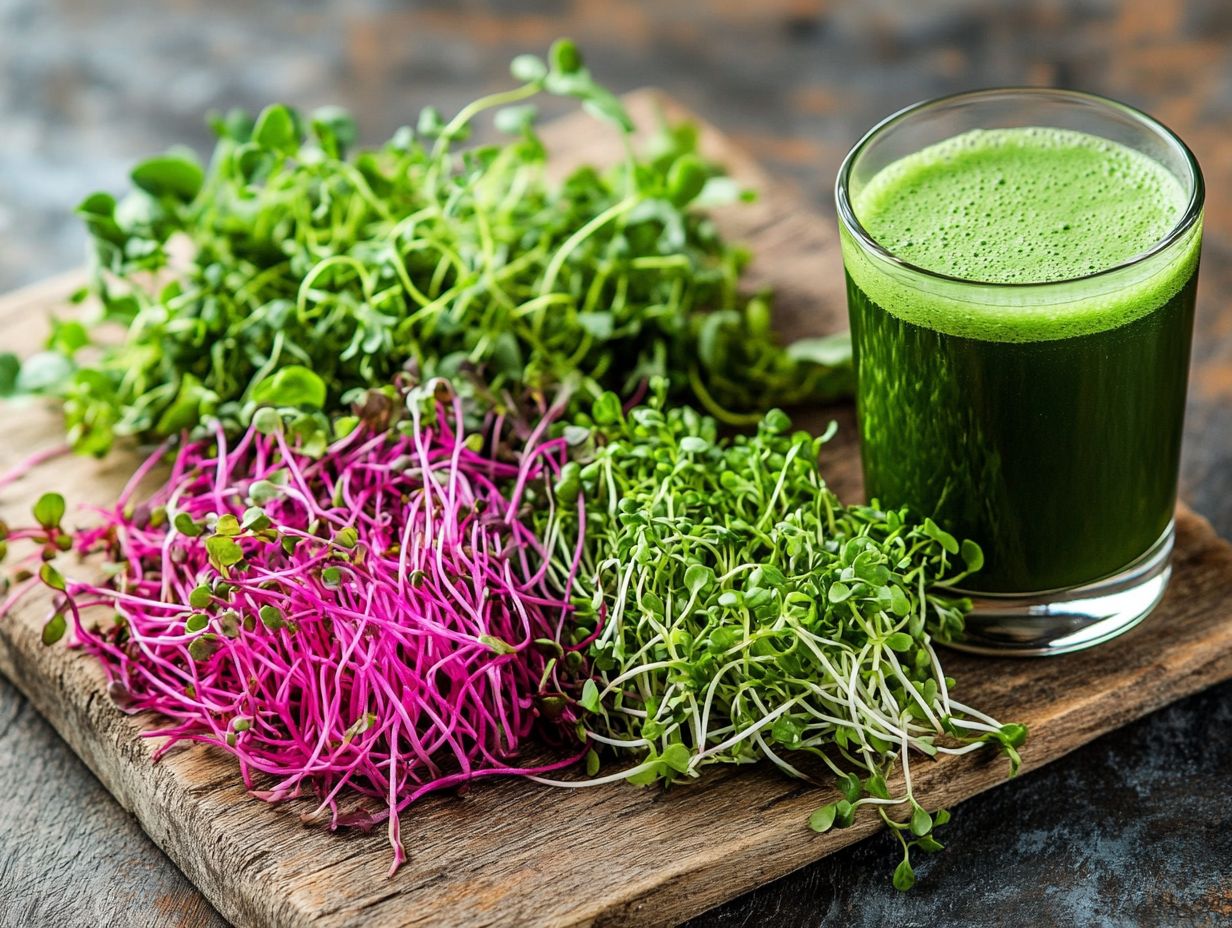
- Juicing microgreens gives you fantastic health benefits thanks to their high nutrient content that’s easily absorbed by the body.
- Some of the best microgreens for juicing include wheatgrass, kale, and broccoli sprouts, which provide unique health benefits such as detoxification and anti-inflammatory properties. Sprouted lentils are also a great addition for their earthy flavor.
- Growing microgreens for juicing can be done easily at home with a few simple steps, making it a cost-effective and convenient way to add extra nutrition to your diet.
What are Microgreens?
Microgreens are young, edible plants that you can harvest just after their first true leaves have developed. They offer a delightful array of flavors, nutrients, and culinary applications, making them a favorite among health lovers.
These tiny greens, including varieties like wheatgrass, broccoli sprouts, and alfalfa sprouts, are visually appealing and remarkably nutrient-dense, providing substantial amounts of vitamins, minerals, and antioxidants that support your well-being.
The growth process of microgreens is refreshingly simple and swift, typically taking just 7 to 21 days from planting to harvest. This makes them an excellent choice for home gardeners like you. Whether you choose to grow them indoors or outdoors, they thrive in various environments, enhancing their accessibility.
Culinary applications for microgreens are impressively diverse. You can easily incorporate them into salads, sandwiches, and smoothies, or use them as vibrant garnishes to elevate your dish presentation. Their intense flavors ranging from peppery to sweet add depth to your meals, while their nutritional benefits, such as high levels of vitamin C and healthy fats, contribute to your overall health.
The visual allure of microgreens not only brightens your plates but also engages diners, making these small plants a true game-changer in modern cuisine.
Benefits of Juicing Microgreens
Juicing microgreens has become a favored trend among health lovers, and for good reason. These greens provide a wealth of health benefits that can elevate your wellness game, offering enhanced nutrient absorption and a substantial energy boost.
If you re seeking a low-calorie, nutrient-dense addition to your diet, look no further. When juiced, these petite powerhouses deliver a concentrated dose of vitamins, minerals, and antioxidants, promoting your overall health and invigorating your lifestyle.
Nutritional Value and Health Benefits
The nutritional value of microgreens is truly impressive, often boasting higher concentrations of vitamins, minerals, and antioxidants compared to their mature counterparts. This makes them a remarkable addition to your healthy diet. For example, varieties like wheatgrass and beet microgreens are brimming with vitamins A, C, E, and K, alongside essential minerals such as iron and magnesium offering a nutrient-dense option that can elevate your overall well-being.
The abundant vitamin C found in microgreens is a significant ally for your immune system, helping your body fend off infections with grace. Antioxidants like flavonoids and carotenoids present in these petite greens play a vital role in combating oxidative stress (the imbalance between free radicals and antioxidants in your body), thus reducing the risk of chronic diseases.
Nutrient-rich choices like mustard, radish microgreens, and sprouted lentils provide high levels of potassium and calcium, crucial for maintaining healthy blood pressure and robust bones.
This exceptional nutrient density transforms microgreens into not only a flavorful addition but also an excellent choice for anyone looking to enhance their diet and boost their health.
Best Microgreens for Juicing
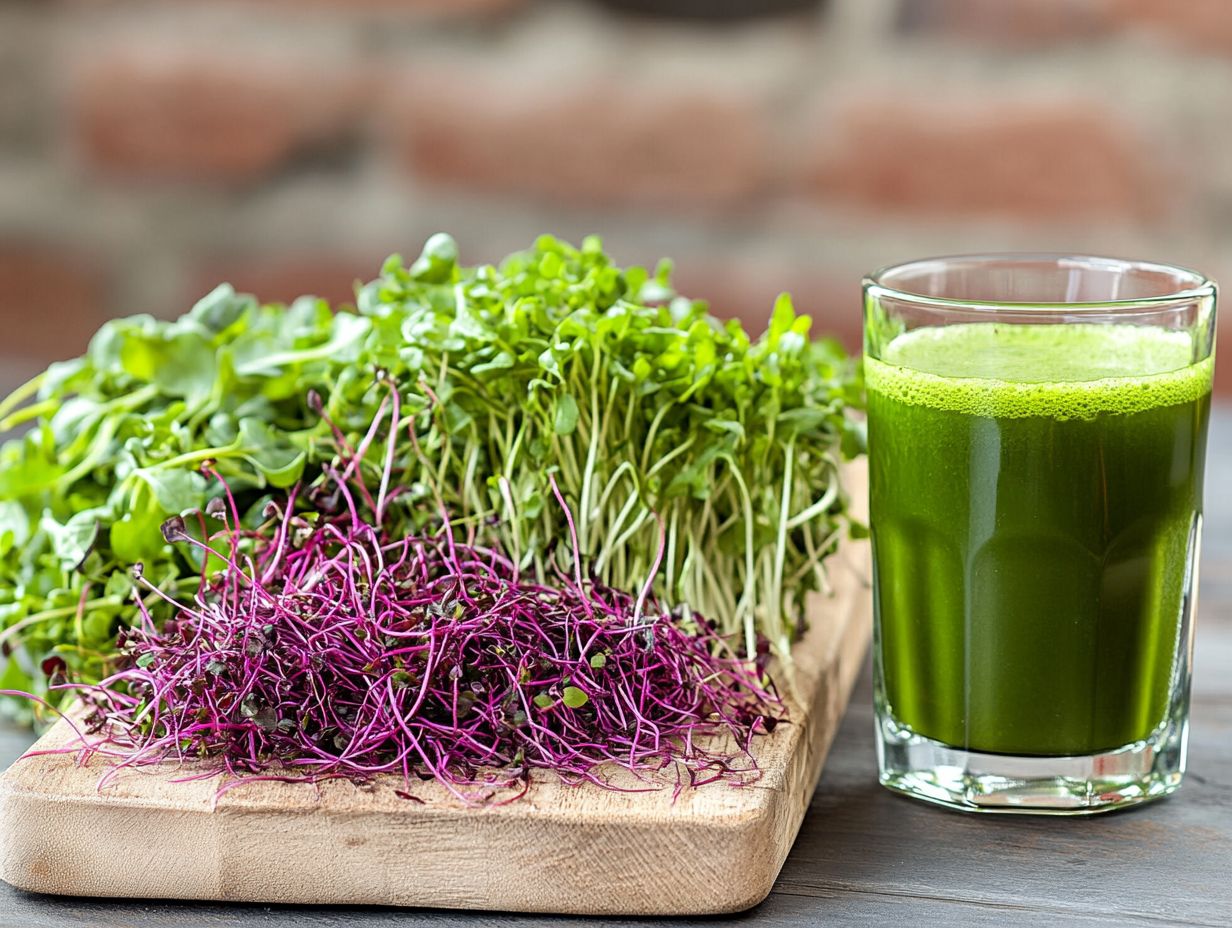
When it comes to juicing, certain microgreens truly shine, offering exceptional flavor profiles and remarkable health benefits. For any juicing enthusiast, broccoli sprouts, radish sprouts, and sunflower sprouts emerge as prime choices.
Their unique flavors and versatility in various juice recipes ensure a smooth texture and enrich your juice with a wealth of nutrients.
Top Microgreens for Juicing and Their Benefits
The top microgreens for juicing are nutrient-rich options that elevate your health and your juice. Beet microgreens, with their vibrant color and exceptional health benefits, are a favorite among juicing enthusiasts. Clover and pea sprouts add sweetness and are versatile.
Clover sprouts and pea sprouts not only enhance the overall flavor profile of your fresh juice, but they re also a breeze to grow at home.
Broccoli microgreens are another stellar choice, packed with vitamins and antioxidants that can strengthen your immune system and support your overall health. Their slightly peppery flavor pairs beautifully with fruits like apples and citrus, resulting in a refreshingly delightful blend.
Prefer bold flavors? Radish greens add a zesty kick and impressive detoxifying properties to the table. For those of you eager to grow these microgreens at home, simple DIY kits requiring minimal space and effort make the process both enjoyable and rewarding.
Harvesting fresh greens from your kitchen is exciting! You ll find yourself adding a personal touch to your juicing experience.
How to Grow Microgreens for Juicing
Growing microgreens for juicing can be an immensely rewarding endeavor. They’re super easy to grow and perfect for small spaces! This makes them ideal for anyone eager to incorporate fresh greens into their diet, especially when using high-quality seeds.
By leveraging DIY kits and following straightforward techniques, you can achieve a plentiful harvest of nutrient-rich microgreens (soil that supplies essential nutrients) that are perfect for juicing, providing you with an instant health boost.
Step-by-Step Guide to Growing Microgreens
A step-by-step guide to growing microgreens can transform even the most inexperienced gardeners into mini harvest maestros, providing fresh greens right in your kitchen perfect for juicing. By grasping the essentials of planting, watering, and harvesting microgreens, you can savor both their culinary delights and health benefits while enjoying the aesthetics they bring to your dishes.
Begin with easy-to-grow varieties like basil, radish, and sunflower; selecting high-quality seeds is crucial for your success. First, choose a shallow container with drainage holes and fill it with a nutrient-rich growing medium. Scatter the seeds evenly across the surface, lightly pressing them in before misting with water.
These young greens thrive in bright, indirect light, making a spot near a window ideal. Keep the soil moist by watering regularly to encourage strong growth! Once they reach around two inches tall typically about 7-14 days post-sowing it s time to harvest.
To keep them fresh, store your microgreens in an airtight container in the refrigerator, making it easy to incorporate these nutritious gems into salads, smoothies, and, of course, those delicious juices.
Tips for Juicing Microgreens
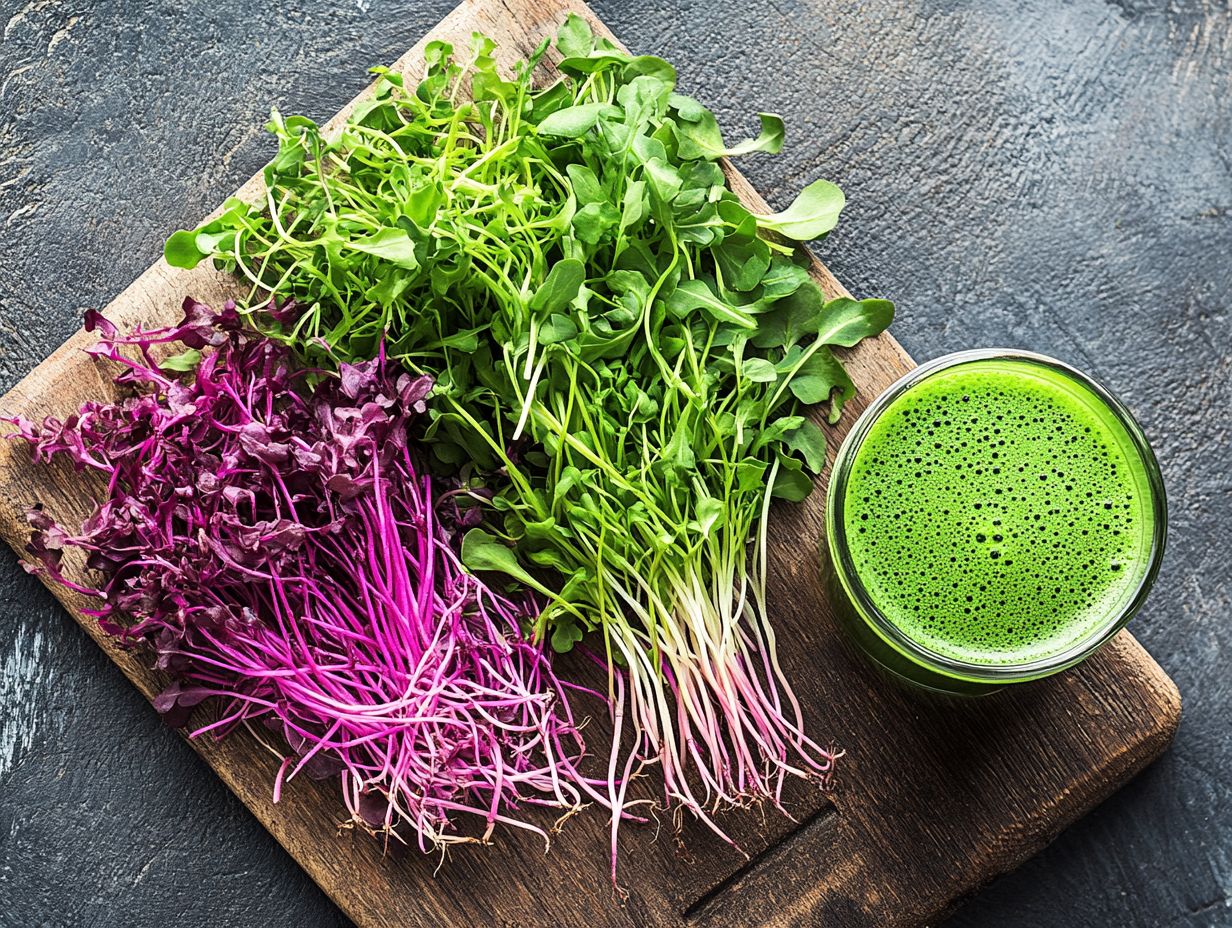
To truly maximize the benefits of juicing microgreens, use these juicing tips to get the most out of your microgreens! Effective juicing techniques elevate both nutrient absorption and flavor. This approach allows you to experience the complete spectrum of health advantages these powerful greens offer.
By incorporating strategies for achieving a smooth consistency in your juice, you ensure that every sip is brimming with the vitamins and minerals these nutrient-dense greens provide.
Maximizing Nutrient Absorption and Flavor
Maximizing nutrient absorption and flavor when juicing microgreens is essential for reaping the full health benefits these superfoods offer. There are several techniques at your disposal to achieve this.
By experimenting with various flavor combinations and employing the best juicing methods, you can create delicious, nutrient-packed juices that are not only refreshing but also highly beneficial to your health!
Try adding ingredients like citrus fruits, ginger, or apples to enhance the taste while boosting nutrient absorption. These vitamin C-rich components are quite helpful for iron absorption.
Blending microgreens with hydrating vegetables like cucumber or celery will improve the consistency of your juice and balance the flavors, making it far more enjoyable.
Don t overlook the power of fresh herbs! Adding basil or mint can introduce unique flavor profiles, elevating your overall experience. Focusing on diversity in your juicing enhances your wellness journey.
Each sip can be a concentrated source of vitamins and antioxidants.
Frequently Asked Questions
Here are some common questions about juicing microgreens:
What Are the Best Microgreens for Juicing?
The best microgreens for juicing include wheatgrass, broccoli, kale, spinach, pea shoots, and sunflower greens. These microgreens are packed with nutrients and add a delicious flavor to juices.
Why are microgreens a great addition to juices?
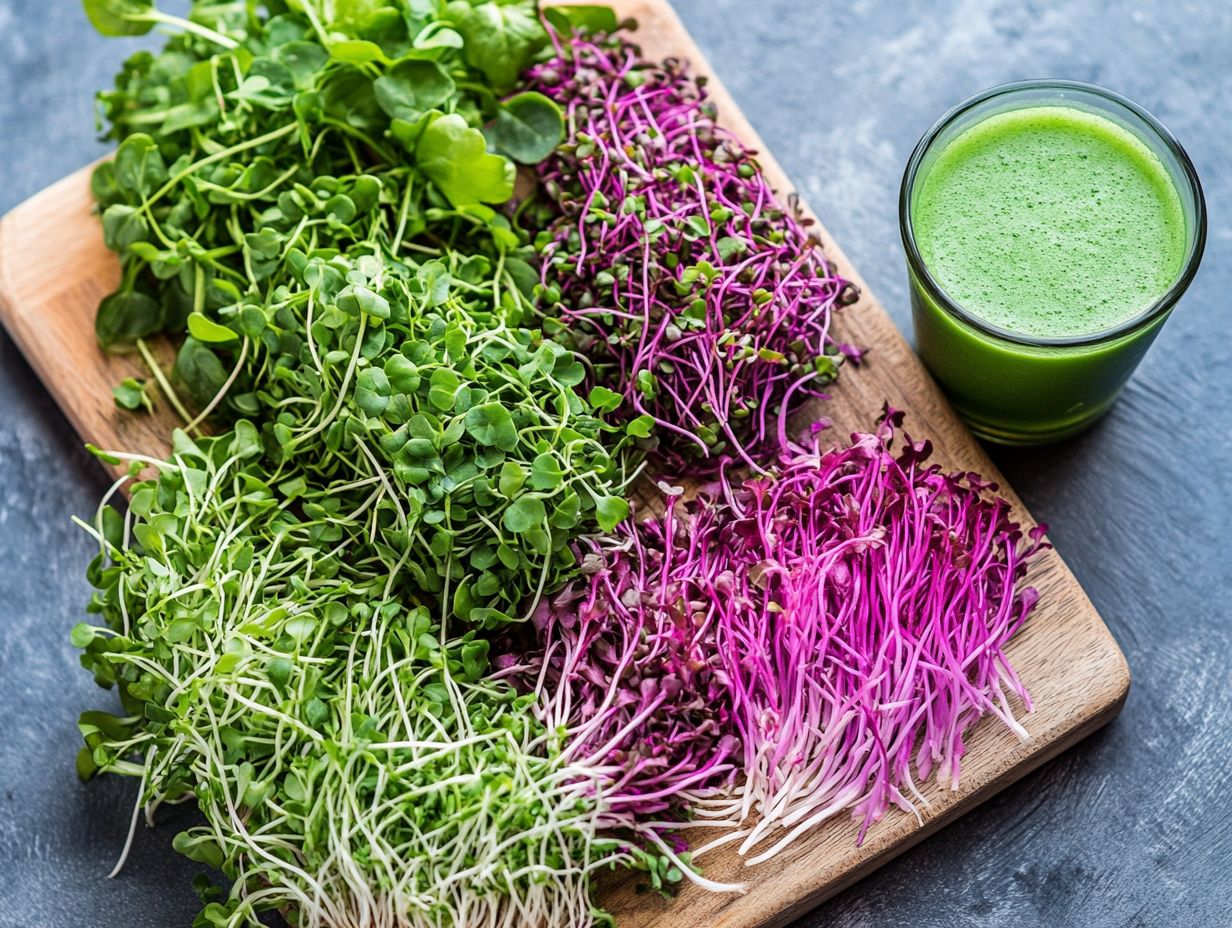
Microgreens are a great addition to juices because they are young plants harvested for their flavors and nutrients. They also add a vibrant color to juices.
Can I use any type of microgreens for juicing?
While most microgreens can be juiced, some are better suited for this purpose. Look for microgreens with a strong flavor, such as wheatgrass, or those with a high water content, such as pea shoots, for a more enjoyable juicing experience.
Do microgreens lose nutrients when juiced?
There may be a slight loss of nutrients when juicing microgreens, but they still retain a high concentration of vitamins, minerals, and antioxidants. To get the maximum benefit, it’s best to drink your juice immediately after juicing.
Can I mix different types of microgreens in my juice?
Absolutely! Mixing different types of microgreens in your juice not only adds a variety of nutrients but also creates a unique flavor profile. Experiment with different combinations to find your favorite mix.
Are there any microgreens that should not be juiced?
While most microgreens can be juiced, some may have a bitter taste or unpleasant texture when juiced, such as cilantro or arugula. It’s best to avoid these when making juices and use them in other dishes instead.
Ready to elevate your health? Grab your microgreens and start juicing today!

